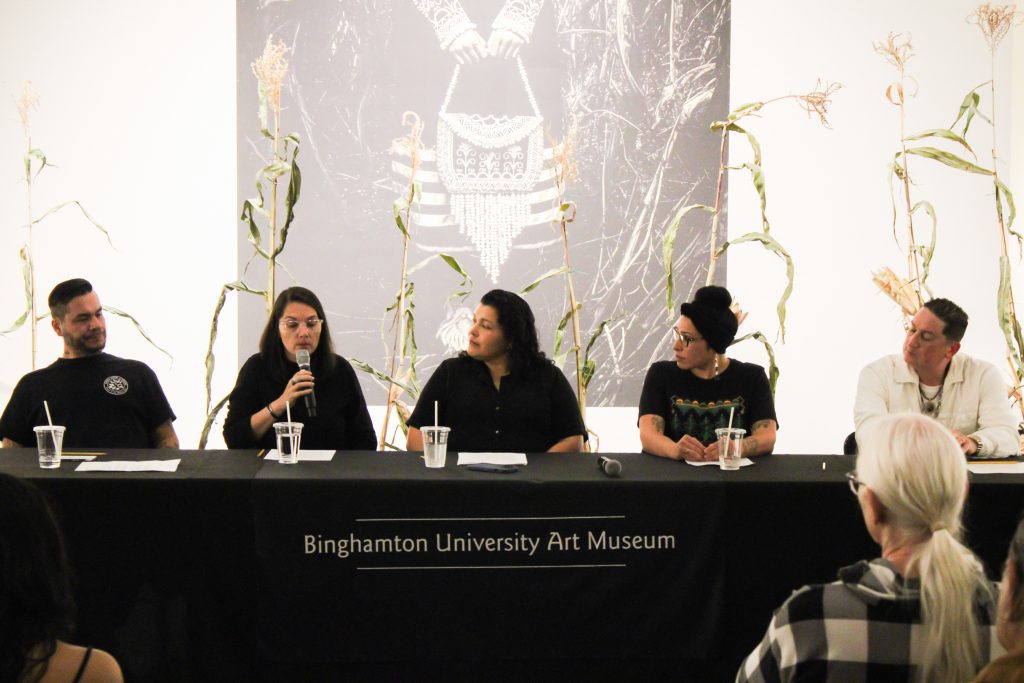The Binghamton University Art Museum kicked off the weekend’s Haudenosaunee festival with a talk from the artists and curator on Oct. 17 behind their current main exhibition. The artists and curator of the “Homelands: Contemporary Haudenosaunee Art Across New York” discussed their art and culture with those in attendance.
The event began with a tribute and thanks to the land delivered by Tony Gonyea of the Onondaga Nation’s Beaver Clan. While the tribute took place in the opening remarks, it certainly did not stop there. Value and gratitude for the land and all it has to offer could be seen throughout the talk in the artists’ messages and in their artwork itself. The exhibit features art from Haudenosaunee artists who have woven their relationships and the value of nature into their work, centering it as a main focal point of their pieces.
The heavy emphasis on the value of nature, ancestry and relationship was reflected throughout the conversations and questions. It was noted in the first conversation question that the exhibit itself was relationship-based. Whether about the land, other people or their ancestors, each of the artists spoke about how they felt their artwork connected them deeper to an aspect of their communities.
Natasha Smoke Santiago, one of the artists and a member of the Mohawk Nation, spoke about her work as a potter and her newest project that uses ancestral Mohawk clay. She also spoke about the importance of revitalizing the art in her community as one of its few potters.
“It feels really important and really special to be able to take something that was lost from our culture because it’s not that often that you can get back something that was gone,” Santiago said. “Once your language is gone, it’s gone.”
The artists elaborated on the importance of relationships within their community and capturing that within their art. Hayden Haynes, 41, of the Seneca Nation of Indians’ Deer Clan, who works from the Seneca-Allegany territory in western New York, noted the importance of women within Indigenous communities and how his artwork holds feminine forms and attributes to capture that. Haynes also mentioned the importance of teaching art and passing down methods to maintain a sense of knowledge within a community.
“When somebody was teaching somebody to carve an antler bone, there’s an interaction that takes place there, within those communities,” Haynes said. “Language was shared through that process, stories, relationships — all that type of stuff.”
Not only are the land and communities reflected in the art, but there is representation in the materials themselves. When Luanne Redeye, 39, of Berkeley, California, a guest curator of the exhibition and an assistant professor of art practice at the University of California, was asked about the importance of a diverse use of materials for the art in the exhibit, she highlighted how the varying natural materials used was important in reflecting the diverse relationships, histories and stories Indigenous communities hold with the land.
“I thought about ways in which as artists or members of modern society, that we can share our perspectives of our work and what we’re thinking in a multitude of materials and ways of expressions,” Redeye said. “Even with paintings and histories in western art — to bring that in and to then create something from your perspective or from the artist’s perspective or with a hand that is tied to a specific community, I think it really grows and expands the definition of what can be Native art.”
The event concluded with acknowledging the importance of sharing knowledge, educating different communities and the significance and strength of the Haudenosaunee community. Many artists shared how speaking about the history of the community and translating that into art is crucial in maintaining and preserving Indigenous communities in the future.
The “Homelands: Contemporary Haudenosaunee Art Across New York” exhibit is open now and will remain on view at the BU Art Museum through Dec. 7.



